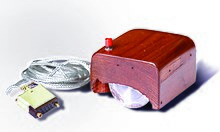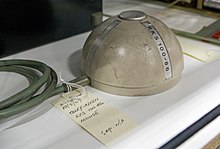Computer mouse
Computer mouse
Computer mouse: A computer mouse is a hand-held pointing device that detects two-dimensional motion relative to a surface. This motion is typically translated into the motion of a pointer on a display, which allows a smooth control of the graphical user interface of a computer.
The first public demonstration of a mouse controlling a computer system was in 1968. Mice originally used a ball rolling on a surface to detect motion, but modern mice often have optical sensors that have no moving parts. Originally wired to a computer, many modern mice are cordless, relying on short-range radio communication with the connected system.
In addition to moving a cursor, computer mice have one or more buttons to allow operations such as the selection of a menu item on a display. Mice often also feature other elements, such as touch surfaces and scroll wheels, which enable additional control and dimensional input.
Naming:The earliest known publication of the term mouse as referring to a computer pointing device is in Bill English's July 1965 publication, "Computer-Aided Display Control" likely originating from its resemblance to the shape and size of a mouse, a rodent, with the cord resembling its tail.[1][2][3]
The plural for the small rodent is always "mice" in modern usage. The plural of a computer mouse is either "mouses" or "mice" according to most dictionaries, with "mice" being more common.[4] The first recorded plural usage is "mice"; the online Oxford Dictionaries cites a 1984 use, and earlier uses include J. C. R. Licklider's "The Computer as a Communication Device" of 1968.[5] The term computer mouses may be used informally in some cases. Although the plural of a mouse (small rodent) is mice, the two words have undergone a differentiation through usage.
History:The trackball, a related pointing device, was invented in 1946 by Ralph Benjamin as part of a post-World War II-era fire-control radar plotting system called Comprehensive Display System (CDS). Benjamin was then working for the British Royal Navy Scientific Service. Benjamin's project used analog computers to calculate the future position of target aircraft based on several initial input points provided by a user with a joystick. Benjamin felt that a more elegant input device was needed and invented what they called a "roller ball" for this purpose.[6][7]
The device was patented in 1947,[7] but only a prototype using a metal ball rolling on two rubber-coated wheels was ever built, and the device was kept as a military secret.[6]
Another early trackball was built by Kenyon Taylor, a British electrical engineer working in collaboration with Tom Cranston and Fred Longstaff. Taylor was part of the original Ferranti Canada, working on the Royal Canadian Navy's DATAR (Digital Automated Tracking and Resolving) system in 1952.[8]
DATAR was similar in concept to Benjamin's display. The trackball used four disks to pick up motion, two each for the X and Y directions. Several rollers provided mechanical support. When the ball was rolled, the pickup discs spun and contacts on their outer rim made periodic contact with wires, producing pulses of output with each movement of the ball. By counting the pulses, the physical movement of the ball could be determined. A digital computer calculated the tracks and sent the resulting data to other ships in a task force using pulse-code modulation radio signals. This trackball used a standard Canadian five-pin bowling ball. It was not patented, since it was a secret military project.[9][10]
Douglas Engelbart of the Stanford Research Institute (now SRI International) has been credited in published books by Thierry Bardini,[11] Paul Ceruzzi,[12] Howard Rheingold,[13] and several others[14][15][16] as the inventor of the computer mouse. Engelbart was also recognized as such in various obituary titles after his death in July 2013.[17][18][19][20]
By 1963, Engelbart had already established a research lab at SRI, the Augmentation Research Center (ARC), to pursue his objective of developing both hardware and software computer technology to "augment" human intelligence. That November, while attending a conference on computer graphics in Reno, Nevada, Engelbart began to ponder how to adapt the underlying principles of the planimeter to X-Y coordinate input.[11] On November 14, 1963, he first recorded his thoughts in his personal notebook about something he initially called a "bug," which in a "3-point" form could have a "drop point and 2 orthogonal wheels."[11] He wrote that the "bug" would be "easier" and "more natural" to use, and unlike a stylus, it would stay still when let go, which meant it would be "much better for coordination with the keyboard."[11]
In 1964, Bill English joined ARC, where he helped Engelbart build the first mouse prototype.[2][21] They christened the device the mouse as early models had a cord attached to the rear part of the device which looked like a tail, and in turn resembled the common mouse.[22] As noted above, this "mouse" was first mentioned in print in a July 1965 report, on which English was the lead author.[1][2][3] On 9 December 1968, Engelbart publicly demonstrated the mouse at what would come to be known as The Mother of All Demos. Engelbart never received any royalties for it, as his employer SRI held the patent, which expired before the mouse became widely used in personal computers.[23] In any event, the invention of the mouse was just a small part of Engelbart's much larger project of augmenting human intellect.[24][25]
Several other experimental pointing-devices developed for Engelbart's oN-Line System (NLS) exploited different body movements – for example, head-mounted devices attached to the chin or nose – but ultimately the mouse won out because of its speed and convenience.[27] The first mouse, a bulky device (pictured) used two potentiometers perpendicular to each other and connected to wheels: the rotation of each wheel translated into motion along one axis.[28] At the time of the "Mother of All Demos", Engelbart's group had been using their second generation, 3-button mouse for about a year.
On October 2, 1968, a mouse device named Rollkugel (German for "rolling ball") was described as an optional device for its SIG-100 terminal was developed by the German company As the name suggests and unlike Engelbart's mouse, the Telefunken model already had a ball. It was based on an earlier trackball-like device (also named that was embedded into radar flight control desks. This trackball had been developed by a team led by Rainer Mallebrein at Telefunken Konstanz for the German Bundesanstalt für Flugsicherung (Federal Air Traffic Control) as part of their TR 86 process computer system with its SIG 100-86 vector graphics terminal.
When the development for the Telefunken main frame TR 440 began in 1965, Mallebrein and his team came up with the idea of "reversing" the existing Rollkugel into a moveable mouse-like device, so that customers did not have to be bothered with mounting holes for the earlier trackball device. Together with light pens and trackballs, it was offered as an optional input device for their system since 1968. Some Rollkugel mouses installed at thein Munich in 1972 are well preserved in a museum. Telefunken considered the invention too unimportant to apply for a patent on it.
The was one of the first computers designed for individual use in 1973 and is regarded as the first modern computer to utilize a mouse. Inspired by Alto, the computer which had been developed by a team around 1978 and 1980, provided a mouse as well. The third marketed version of an integrated mouse shipped as a part of a computer and intended for personal computer navigation came in 1981.
By 1982, the Xerox 8010 was probably the best-known computer with a mouse. The Sun-1 also came with a mouse, and the forthcoming was rumored to use one, but the peripheral remained obscure; Jack Hawley of The Mouse House reported that one buyer for a large organization believed at first that his company sold. Hawley, who manufactured mice for Xerox, stated that "Practically, I have the market all to myself right now"; a Hawley mouse cost $415. In 1982, introduced the P4 Mouse at the Comdex trade show in Las Vegas, its first hardware mouse That same year made the decision to make the program mouse-compatible, and developed the first PC-compatible mouse. Microsoft's mouse shipped in 1983, thus beginning the division of the company. However, the mouse remained relatively obscure until the appearance of the (which included an updated version of thein 1984, and of the and the in 1985.
Operation:A mouse typically controls the motion in two dimensions in a graphical user interface (GUI). The mouse turns movements of the hand backward and forward, left and right into equivalent electronic signals that in turn are used to move the pointer.
The relative movements of the mouse on the surface are applied to the position of the pointer on the screen, which signals the point where actions of the user take place, so hand movements are replicated by the pointer. Clicking or hovering (stopping movement while the cursor is within the bounds of an area) can select files, programs, or actions from a list of names, or (in graphical interfaces) through small images called "icons" and other elements. For example, a text file might be represented by a picture of a paper notebook, and clicking while the cursor hovers this icon might cause a text editing program to open the file in a window.
Different ways of operating the mouse cause specific things to happen in the GUI:
- Click: pressing and releasing a button.
- (left) clicking the main button.
- (left) clicking the button two times in quick succession counts as a different gesture than two separate single clicks.
- (left) : Clicking the button three times in quick succession counts as a different gesture than three separate single clicks. Triple clicks are far less common in traditional navigation.
- : clicking the secondary button, or clicking with two fingers. (This brings a menu with different options depending on the software)
- Middle-click: clicking the tertiary button.
- pressing and holding a button, then moving the mouse without releasing. (Using the command " instead of just "drag" when one instructs a user to drag an object while holding the right mouse button down instead of the more commonly used left mouse button.)
- (a.k.a. Rocker navigation).
- Combination of right-clicking then left-click.
- Combination of left-clicking then right-clicks or keyboard letter.
- Combination of left or right-click and the mouse wheel.
- Clicking while holding down.
- Moving the pointer a long distance: When a practical limit of mouse movement is reached, one lifts up the mouse, brings it to the opposite edge of the working area while it is held above the surface, and then replaces it down onto the working surface. This is often not necessary, because acceleration software detects fast movement, and moves the pointer significantly faster in proportion than for slow mouse motion.
- Multi-touch: this method is similar to a multi-touch trackpad on a laptop with support for tap input for multiple fingers, the most famous example being .










No comments